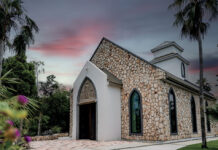No country can lay claim to the barbecue. This time-honoured practice, which can be traced back to our first ancestors, is found in many different forms across the world. Yet all have one thing in common – the cooking of delicious food over fire. From the bazaars of the Middle East to the markets of Southeast Asia, from the backyards of Scandinavia to the beaches of the Caribbean, every continent, indeed almost every nation, has their own version of the barbecue. So sit back as InsideOut takes you on a global tour of the barbecue.
United States
In the United States, the definition of the barbecue can be as diverse as the nation itself. From outdoor charcoal grills to open fire pits, there are countless ways to barbecue – and everyone believes their way is best. The heart of the barbecue culture lies in the south-east, where many regions offer their own interpretation of this culinary art form, with varying cooking styles and ingredients. Americans predominantly use marinated or dry rubbed pork and beef, usually smoked or grilled over charcoal or hard wood coals.
After a slow cooking process, the meat is topped with barbecue sauce. Sauce is often the great divide between regions; in Memphis, a hot, sweet, tomato-based sauce is used; in Kansas, sauce consists of tomatoes and molasses and is thick and sweet; in South Carolina, the sauce is made with yellow mustard, brown sugar, vinegar and spices.
The Caribbean
The most popular example of Caribbean barbecuing is the Jamaican jerk. A range of meats are dry rubbed or marinated with the fiery jerk seasoning, a mixture of pimento, Scotch bonnet peppers and other herbs and spices, then smoked or grilled over wood charcoal. Barbecuing can be found throughout the Caribbean Islands, where it varies according to local ingredients or traditions.
South America
In the South American countries of Argentina, Chile, Paraguay and Uruguay, the barbecue, or asado, is the national dish. A fire is made on the ground and once coals are formed, a grill is placed over the top for the meat to cook on. Often a whole animal is cooked on the fire, or different cuts of meat including steak, pork, lamb, baby goat, chicken, chorizo, as well as vegetables and cheeses. The cooked meat is often topped with chimichurri, a sauce made from garlic, parsley, oil, vinegar, chilli and additional spices. In Brazil, asado is known as churrasco and is often seasoned with Brazilian spices.
Europe
The sheer diversity of the European continent means that a barbecue can entail a different meat and a different cooking method, depending on the country. In Greece, souvlaki is a traditional dish in which lamb is skewered and cooked over a grill. In Germany, charcoal barbecues are used to cook the national meat of choice, the sausage, in its many local variations. In Russia, the shashlik, a local variation of the shish kebab, is slow-cooked over a grill or open fire. Barbecuing is even popular in Scandinavia, featuring elements of traditional Scandinavian food, such as wild game and venison, and sauces made from juniper berries. The British version include elements of the Australian, Scandinavian, American and Mediterranean varieties, with meats that range from chicken to shish kebabs, and a diverse variety of marinades and sauces, usually cooked on a kettle-style or built-in barbecue.
South Africa
You won’t find a barbecue in South Africa, but you will find a braai, the traditional Afrikaans method of cooking meat over an open-fire grill, or braaier. A braai is a big social occasion, and can also be found in Botswana, Zimbabwe, Namibia, Zambia and Lesotho. Ingredients usually include sausages, kebabs, chicken, lamb, steaks and seafood, eaten with a thickened porridge called pap.
Middle East
The most well-known form of Middle Eastern barbecue is the shish kebab, skewered meat grill on outdoor coals. The main meats used are lamb, beef, chicken and non-pork sausages, usually served with hummus, tahini, pita bread and tabouli.
Asia
When discussing barbecues, Asia might not be the first continent that springs to mind. But this extensive region is also brimming with variations of this cooking method. In eastern Asia, pork and beef are the most popular meats, usually topped with soy- or honey-based sauces and marinades. In many Southeast Asian countries, meat marinated in a satay sauce, consisting of crushed peanuts and curry, is skewered on a bamboo stick over a charcoal flame.
The Philippines traditionally celebrates momentous occasions with a lechon, in which a suckling pig is slow roasted on a rotisserie over a fire. And in South Asia, the barbecue takes the form of the tandoor, a clay oven that can reach temperatures of 900°F. Found in India, Bangladesh, Pakistan and a number of other countries, a tandoor is used to cook such foods as chicken tikka, tandoori chicken and roti and naan breads.
Australia & New Zealand
Down Under, the barbie is not just for shrimp (or prawns, as they are known locally), but for all manner of meat and seafood. Barbecuing is a national art form in Australia, with strong connotations of summer. Most meat is cooked on a grill or a hot plate, while smoking or charcoal is used less often. The barbie is also popular in neighbouring New Zealand, where it takes a similar form to Australia. The Maoris still use a traditional cooking method called hangi, in which food is barbecued over heated stones buried in a pit oven. Meats and vegetables are wrapped in leaves or foil and placed in the pit to cook






























